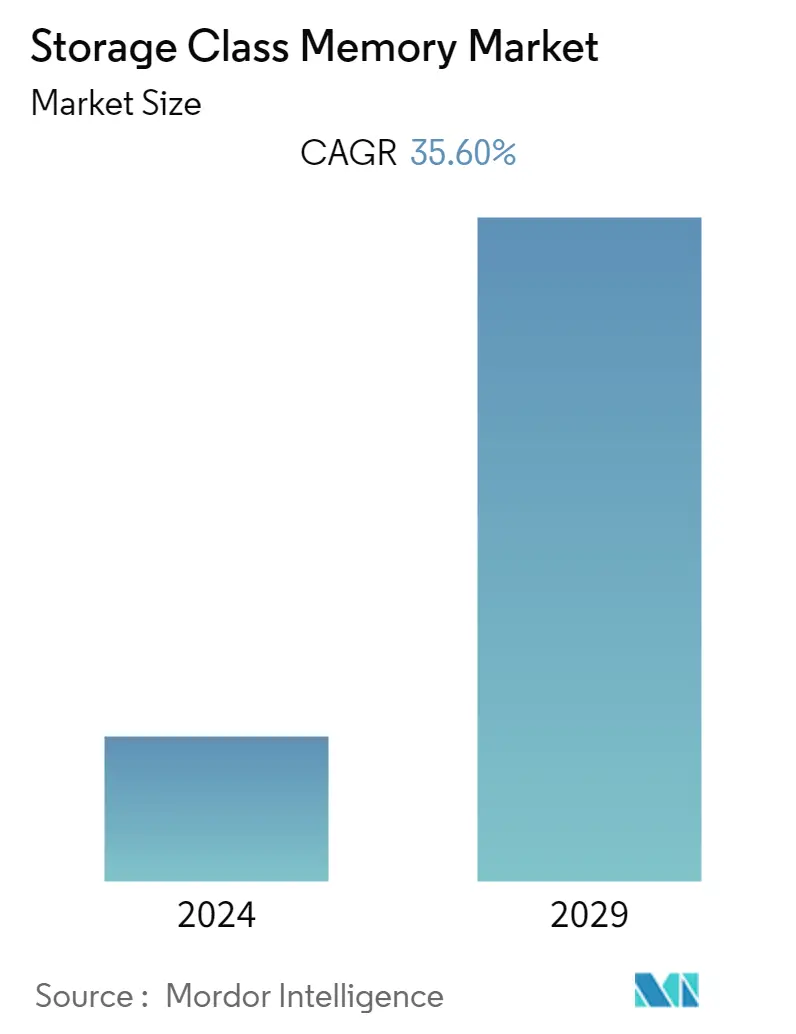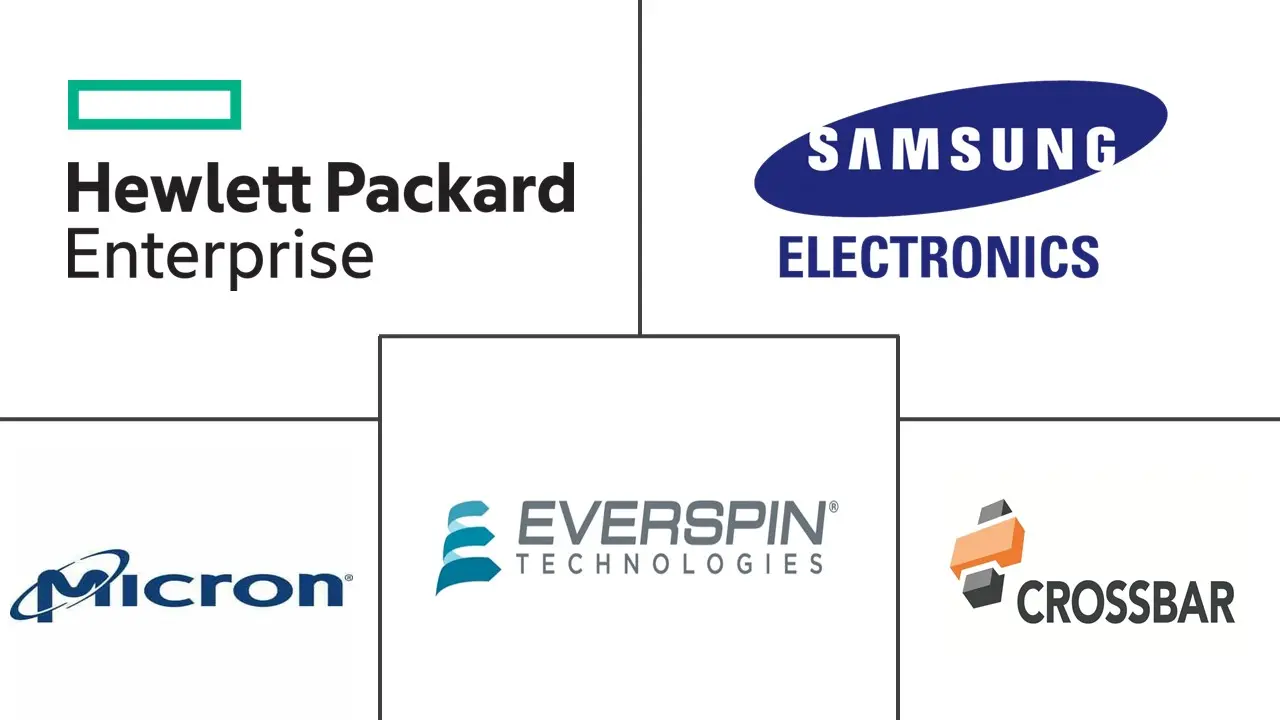Market Size of Storage Class Memory Industry

| Study Period | 2019 - 2029 |
| Base Year For Estimation | 2023 |
| CAGR | 35.60 % |
| Fastest Growing Market | North America |
| Largest Market | North America |
| Market Concentration | High |
Major Players
*Disclaimer: Major Players sorted in no particular order |
Storage Class Memory Market Analysis
The Storage Class Memory (SCM) Market is projected to register a CAGR of 35.6% during the forecast period. SCM fills the specific performance and reliability gap in the memory hierarchy. Its use cases range from high-performance storage cache to a replacement for flash for faster storage media due to its addressability at the block and byte levels.
- Storage Class Memory (SCM) is a critical component in the transition from rotating mechanical storage, such as disk drives, to solid-state, non-volatile RAM. As a result, SCM promises to deliver higher-performance and more energy-efficient solutions than existing SLC/MLC NAND flash products.
- Storage Class Memory (SCM) is faster for reading and writing operations than NAND flash. Furthermore, it has higher endurance properties due to being significantly more resistant to data rewrites. SCM features include advantages over NAND flash and a lower cost per GB when compared to DRAM.
- Furthermore, the ability to perform at near-memory speeds, as well as ultra-high endurance and persistence through power outages, makes SCM suitable for latency-sensitive applications such as financial trading applications, analytics, direct-attached storage applications, and databases.
- The demand for in-memory processing increasingly used in Big Data applications, like interactive database queries, has prompted Intel and other chipmakers to boost memory bandwidth. When running analytics workloads, such as the Spark-based cluster computing framework, Intel claims queries run eight times faster on persistent memory than on DRAM storage combinations.
- The rise of application containers in data centers also has boosted requirements for persistent memory in recent years. Hence, vendors present in the market ecosystem are emphasizing the advantages of larger persistent memory tiers, including increased CPU and server utilization and the faster delivery of distributed applications.
- Moving forward, when digital data is stored in non-volatile memory, it is essential to have a mechanism for detecting and correcting specific errors. Error correction code (ECC) offers to encode data so that a decoder can identify and correct errors in the data.
- Many end-user industries across different nations were affected by the pandemic resulting in the shutdown of various business operations. For instance, the introduction of lockdowns in India indicated shutting down all sectors and activities. These lockdown implementations lead to a massive impact on every industry, with the majority of businesses suffering losses. According to Intel, the increased need for virtualized desktop infrastructure and virtualized storage solutions is driving demand for its storage and memory products in the data center. The need to enhance and accelerate storage and memory capabilities for the two application types has come in response to the large number of workers who moved to home offices and a rise in the use of digital resources that have been prompted by the COVID-19 pandemic. Intel's Non-Volatile Memory Solutions Group saw first-quarter revenue grow 46% year-over-year to USD 1.3 billion.
Storage Class Memory Industry Segmentation
The Storage Class Memory Market is Segmented By Application (SSD (Client SSD and Enterprise SSD), Persistent Memory (Data Center and Workstation)), and Geography. The market study focuses on the trends affecting the market in the major regions like North America, Europe, Asia-Pacific, and the Rest of the World. The study tracks the key market parameters, underlying growth influencers, and major vendors operating in the industry and tracks the impact of COVID-19 on the overall storage class memory industry and its performance.
| Application | ||||
| ||||
|
| Geography | |
| North America | |
| Europe | |
| Asia Pacific | |
| Rest of the World |
Storage Class Memory Market Size Summary
The Storage Class Memory (SCM) market is experiencing significant growth, driven by its ability to bridge the performance and reliability gap in memory hierarchies. SCM serves as a high-performance alternative to traditional storage solutions, offering faster read and write operations and higher endurance compared to NAND flash. This technology is particularly suited for latency-sensitive applications such as financial trading, analytics, and databases, where its near-memory speeds and persistence through power outages provide substantial advantages. The increasing demand for in-memory processing in big data applications and the rise of application containers in data centers have further fueled the need for persistent memory, highlighting its role in enhancing CPU and server utilization and accelerating the delivery of distributed applications.
The market landscape is characterized by the presence of major players like Samsung and Panasonic, which dominate due to their established offerings and the high manufacturing costs associated with SCM, posing challenges for new entrants. The North American region, with its robust data center infrastructure and significant investments in upgradation and expansion, represents a substantial market for SCM. The region's focus on big data analytics, mobile broadband, and cloud computing continues to drive demand for advanced storage solutions. Strategic developments, such as Kioxia's introduction of software-defined interfaces and Micron Technology's release of vertically integrated NAND SSDs, underscore the ongoing innovation within the market. As organizations seek to enhance IT scalability and capacity amidst the exponential growth of data, SCM is poised to play a crucial role in the evolution of next-generation modular data centers.
Storage Class Memory Market Size - Table of Contents
-
1. MARKET DYNAMICS
-
1.1 Market Overview
-
1.2 Introduction to Market Drivers and Restraints
-
1.3 Market Drivers
-
1.3.1 Increased Performance and Reliability by Combining NAND and DRAM Features
-
1.3.2 Faster Computing Power with More Memory
-
-
1.4 Market Challenges
-
1.4.1 High Manufacturing Costs
-
-
1.5 Industry Value Chain Analysis
-
1.6 Industry Attractiveness - Porter's Five Force Analysis
-
1.6.1 Threat of New Entrants
-
1.6.2 Bargaining Power of Buyers
-
1.6.3 Bargaining Power of Suppliers
-
1.6.4 Threat of Substitute Products
-
1.6.5 Intensity of Competitive Rivalry
-
-
1.7 Impact of COVID-19 on the Industry
-
-
2. MARKET SEGMENTATION
-
2.1 Application
-
2.1.1 SSD
-
2.1.1.1 Client SSD
-
2.1.1.2 Enterprise SSD
-
-
2.1.2 Persistent Memory
-
2.1.2.1 Data Center
-
2.1.2.2 Workstation
-
-
-
2.2 Geography
-
2.2.1 North America
-
2.2.2 Europe
-
2.2.3 Asia Pacific
-
2.2.4 Rest of the World
-
-
Storage Class Memory Market Size FAQs
What is the current Storage Class Memory Market size?
The Storage Class Memory Market is projected to register a CAGR of 35.60% during the forecast period (2024-2029)
Who are the key players in Storage Class Memory Market?
Hewlett Packard Enterprise, Everspin Technologies Inc., Crossbar Inc. , Micron Technology Inc. and Samsung Electronics Co. Ltd are the major companies operating in the Storage Class Memory Market.

